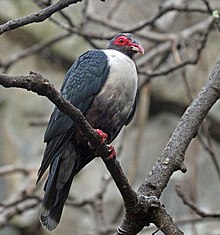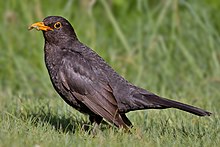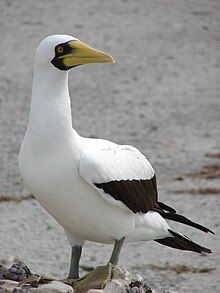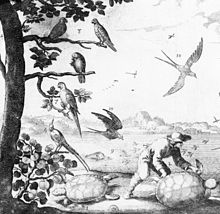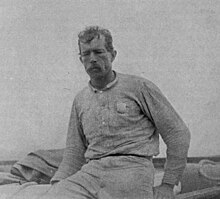Portal:Birds
The Birds Portal

Birds are a group of warm-blooded vertebrates constituting the class Aves (/ˈeɪviːz/), characterised by feathers, toothless beaked jaws, the laying of hard-shelled eggs, a high metabolic rate, a four-chambered heart, and a strong yet lightweight skeleton. Birds live worldwide and range in size from the 5.5 cm (2.2 in) bee hummingbird to the 2.8 m (9 ft 2 in) common ostrich. There are over 11,000 living species, more than half of which are passerine, or "perching" birds. Birds have wings whose development varies according to species; the only known groups without wings are the extinct moa and elephant birds. Wings, which are modified forelimbs, gave birds the ability to fly, although further evolution has led to the loss of flight in some birds, including ratites, penguins, and diverse endemic island species. The digestive and respiratory systems of birds are also uniquely adapted for flight. Some bird species of aquatic environments, particularly seabirds and some waterbirds, have further evolved for swimming. The study of birds is called ornithology.
Birds are feathered theropod dinosaurs and constitute the only known living dinosaurs. Likewise, birds are considered reptiles in the modern cladistic sense of the term, and their closest living relatives are the crocodilians. Birds are descendants of the primitive avialans (whose members include Archaeopteryx) which first appeared during the Late Jurassic. According to recent estimates, modern birds (Neornithes) evolved in the Late Cretaceous and diversified dramatically around the time of the Cretaceous–Paleogene extinction event 66 million years ago, which killed off the pterosaurs and all non-avian dinosaurs.
Many social species pass on knowledge across generations, which is considered a form of culture. Birds are social, communicating with visual signals, calls, and songs, and participating in such behaviours as cooperative breeding and hunting, flocking, and mobbing of predators. The vast majority of bird species are socially (but not necessarily sexually) monogamous, usually for one breeding season at a time, sometimes for years, and rarely for life. Other species have breeding systems that are polygynous (one male with many females) or, rarely, polyandrous (one female with many males). Birds produce offspring by laying eggs which are fertilised through sexual reproduction. They are usually laid in a nest and incubated by the parents. Most birds have an extended period of parental care after hatching.
Many species of birds are economically important as food for human consumption and raw material in manufacturing, with domesticated and undomesticated birds being important sources of eggs, meat, and feathers. Songbirds, parrots, and other species are popular as pets. Guano (bird excrement) is harvested for use as a fertiliser. Birds figure throughout human culture. About 120 to 130 species have become extinct due to human activity since the 17th century, and hundreds more before then. Human activity threatens about 1,200 bird species with extinction, though efforts are underway to protect them. Recreational birdwatching is an important part of the ecotourism industry. (Full article...)
Featured articles
Selected general bird topic

A bird strike (sometimes called birdstrike, bird ingestion (for an engine), bird hit, or bird aircraft strike hazard (BASH)) is a collision between an airborne animal (usually a bird or bat) and a moving vehicle (usually an aircraft). The term is also used for bird deaths resulting from collisions with structures, such as power lines, towers and wind turbines (see bird–skyscraper collisions and towerkill).
A significant threat to flight safety, bird strikes have caused a number of accidents with human casualties. There are over 13,000 bird strikes annually in the US alone. However, the number of major accidents involving civil aircraft is quite low and it has been estimated that there is only about one accident resulting in human death in one billion (109) flying hours. The majority of bird strikes (65%) cause little damage to the aircraft; however, the collision is usually fatal to the bird(s) involved. (Full article...)Selected taxon
The bird family Petroicidae includes 51 species in 19 genera. All are endemic to Australasia: New Guinea, Australia, New Zealand and numerous Pacific Islands as far east as Samoa. For want of an accurate common name, the family is often called the Australasian robins.
Within the family species are known variously as robins, scrub-robins and flyrobins. They are only distantly related to the European robin of Europe, north Africa and western Asia, a member of family Muscicapidae. (Full article...)Topics
Anatomy: Anatomy • Skeleton • Flight • Eggs • Feathers • Plumage
Evolution and extinction: Evolution • Archaeopteryx • Hybridisation • Late Quaternary prehistoric birds • Fossils • Taxonomy • Extinction
Behaviour: Singing • Intelligence • Migration • Reproduction • Nesting • Incubation • Brood parasites
Bird orders: Struthioniformes • Tinamiformes • Anseriformes • Accipitriformes • Galliformes • Gaviiformes • Podicipediformes • Procellariiformes • Sphenisciformes • Pelecaniformes • Ciconiiformes • Phoenicopteriformes • Falconiformes • Gruiformes • Charadriiformes • Pteroclidiformes • Columbiformes • Psittaciformes • Cuculiformes • Strigiformes • Caprimulgiformes • Apodiformes • Coraciiformes • Piciformes • Trogoniformes • Coliiformes • Passeriformes
Bird lists: Families and orders • Lists by region
Birds and humans: Ringing • Ornithology • Bird collections • Birdwatching • Birdfeeding • Conservation • Aviculture
Quotes
| “ | People expect the clergy to have the grace of a swan, the friendliness of a sparrow, the strength of an eagle and the night hours of an owl - and some people expect such a bird to live on the food of a canary. | ” |
Resources
Free online resources:
- SORA: The Searchable Online Research Archive (SORA) has decades worth of archives of the following journals: The Auk, The Condor, Journal of Field Ornithology, North American Bird Bander, Studies in Avian Biology, Pacific Coast Avifauna, and The Wilson Bulletin. Coverage ends around 2000. The ability to search all journals or browse exists on the front page.
- Notornis: The Journal of the Ornithological Society of New Zealand covers New Zealand and the South Pacific.
- New Zealand Journal of Ecology: This journal often publishes bird-related articles. Like Notornis, this journal is concerned with New Zealand and surrounding areas.
- Marine Ornithology: Published by the numerous seabird research groups, Marine Ornithology is specific and goes back many years.
- BirdLife International: The Data Zone has species accounts for every species, although threatened species and some key groups have greater detail with others only having status and evaluation.
- Author Index: This is a good source for binomial authorities for taxoboxes.
There is also Birds of North America, Cornell University's massive project collecting information on every breeding bird in the ABA area. It is available for US$40 a year.
For more sources, including printed sources, see WikiProject Birds.
WikiProjects
Selected images
Selected bird anatomy topic

Notarium or os dorsale is a bone consisting of the fused vertebra of the shoulder in birds and some pterosaurs. The structure helps brace the chest against the forces generated by the wings. In birds, the vertebrae are only in contact with adjacent vertebrae and ribs, while in some pterosaurs the notarium articulates with the scapula. This joint is unique among tetrapods, as in no other taxa is there a direct connection between the pectoral girdle and vertebral column (though in species with clavicles, the clavicle articulates with the sternum, which in turn is connected to the vertebrae via the ribs, allowing an indirect connection).
Among birds, notarium is found among Galliformes, Columbidae, Tinamidae, Podicipedidae, Phalacrocoracidae, Threskiornithidae, Phoenicopteridae, Falconidae, Gruidae, Aramidae, Psophiidae, Rhinochetidae, Eurypygidae, Mesitornithidae, Pteroclididae, Opisthocomidae and Steatornithidae. It contains 2-6 vertebrae. It probably evolved at least 10 times independently in birds. (Full article...)Selected species
The species was on the brink of extirpation in the contiguous United States (while flourishing in much of Alaska and Canada) late in the 20th century, but now has a stable population and has been officially removed from the U.S. federal government's list of endangered species. The bald eagle was officially reclassified from "endangered" to "threatened" on July 12, 1995 by the U.S. Fish & Wildlife Service. On July 6, 1999, a proposal was initiated "To Remove the Bald Eagle in the Lower 48 States From the List of Endangered and Threatened Wildlife."
Did you know
- ...that sexual size dimorphism in the brown songlark is among the most pronounced in any bird, with males as much as 2.3 times heavier than females?
- ...that rufous whistler birds, unlike all other whistler birds, never forage on the ground but high up in trees or other high places?
- ...that the bill of the magpie duck (pictured) becomes green as the bird gets older, and its black crown may go completely white?
Categories
Related portals
Things you can do
Create requested articles (WikiProject Birds – Article requests):
Do these tasks:
 |
Here are some tasks awaiting attention:
|
More outstanding tasks at the project's cleanup listing, Category:Birds articles needing attention, and Wikipedia:WikiProject Birds/Todo.
Taxonomy of Aves
| Class Aves, divided into superorders, orders, suborders (where indicated), and families. | ||||
|---|---|---|---|---|
|
Associated Wikimedia
The following Wikimedia Foundation sister projects provide more on this subject:
-
Commons
Free media repository -
Wikibooks
Free textbooks and manuals -
Wikidata
Free knowledge base -
Wikinews
Free-content news -
Wikiquote
Collection of quotations -
Wikisource
Free-content library -
Wikispecies
Directory of species -
Wikiversity
Free learning tools -
Wikivoyage
Free travel guide -
Wiktionary
Dictionary and thesaurus
Sources
- ^ Applewhite, A.; Evans, T.; Frothingham, A. (2003). And I Quote, Revised Edition: The Definitive Collection of Quotes, Sayings, and Jokes for the Contemporary Speechmaker. Thomas Dunne Books. St. Martin's Press. p. 216. ISBN 978-0-312-30744-8. Retrieved February 7, 2020.







